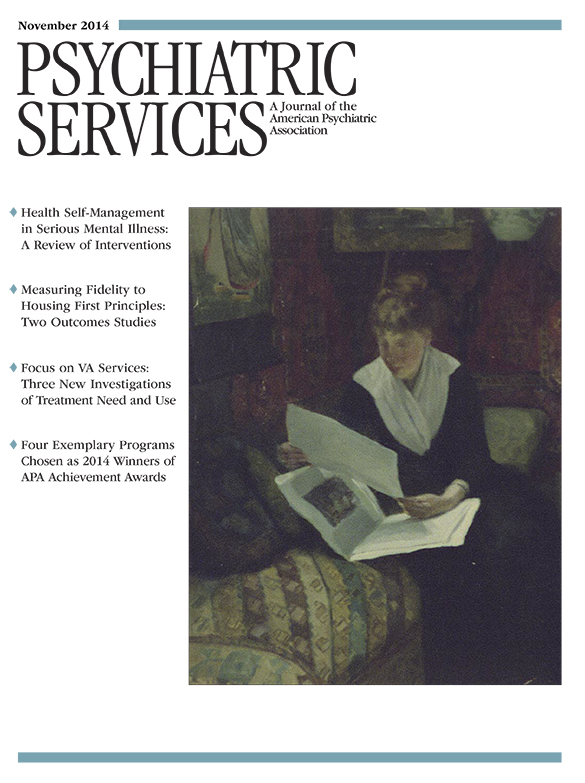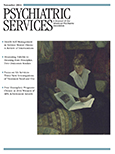Emergency department overcrowding is an increasing problem worldwide. Cross-sectional studies indicate that individual characteristics such as sex, age, health conditions, and comorbidities are associated with high use of emergency departments (
1). However, these characteristics may change, and thus it is uncertain whether they remain significantly associated with emergency department use over time. A longitudinal approach is needed for better health care delivery planning. This study identified factors associated with high use of emergency departments over time among patients with schizophrenia and a co-occurring substance use disorder.
Methods
The cohort consisted of patients with substance use disorders (
ICD-9 codes 291, 292, and 303–305;
ICD-10 codes F10–F19) who received an initial diagnosis of schizophrenia in 2006 (
ICD-9 code 295;
ICD-10 codes F20, F21, F23, F25, and F232) (
2) and had made at least one emergency department visit in fiscal year (FY) 2006–2007. Patient data, including demographic characteristics, diagnoses, and service use, were obtained from the Régie de l’Assurance Maladie du Québec, which operates health administrative databases for all Quebec residents eligible for health services. Data were obtained for the preceding five years starting on the date of their schizophrenia diagnosis. For each year, each patient was classified as a high user of the emergency department or not. High users were in the 95th percentile of annual visits.
Predictor variables were classified according to the Andersen model of health services utilization (
3). General medical comorbidity was measured with an enhanced coding algorithm for the Charlson Comorbidity Index (
4), and psychiatric comorbidities were the sum of organic disorders, paranoid disorders, anxiety disorders, personality disorders, and depressive symptoms. Patients were also classified according to their medical region of residence (based on proximity to a university hospital). Because of the clustered nature of our data, with observations nested within patients over a five-year period, high use of the emergency department over time was modeled with generalized estimating equation (GEE) analyses (
5,
6). Statistical analyses were completed with SAS, version 9.3.
Results
A total of 4,048 persons age 18 and older with incident cases of schizophrenia and a comorbid diagnosis of a substance use disorder were identified in 2006. Of these, 1,127 (28%) did not visit the emergency department in FY 2006–2007. Among the 2,921 patients (72%) who made at least one visit, the mean±SD age was 40.11±14.93; 1,869 (64%) were men, and 2,483 (85%) lived in urban areas. Of the 2,921 patients, 155 (5%) made more than five visits to the emergency department in FY 2006–2007, placing them in the high user category. High users were younger (mean age=38.48±15.04); 90 (58%) were men, and 124 (80%) lived in urban areas.
Four enabling variables were significantly associated with high use: type of medical region and number of days hospitalized and frequency of hospitalization during the preceding five years. Five need variables (all measured during the preceding five years) were also significantly associated with high use: number of psychiatric comorbidities, number of general medical comorbidities, use of second-generation antipsychotics, use of antidepressants, and use of methadone.
Cross-sectional analysis indicated that a one-year increase in age increased the likelihood of high use (OR=.98, p≤.05). Other variables associated with an increased likelihood were frequency of hospitalization (OR=1.10, p<.001), number of psychiatric comorbidities (OR=1.38, p≤.05), and number of general medical comorbidities (OR=1.15, p≤.05). [A table presenting this analysis is available in an online data supplement.]
Multivariate GEE analyses showed that factors significantly associated with being a high user over time were living in a university medical region or in a peripheral medical region (as opposed to a far or isolated medical region), greater frequency of hospitalization, high number of psychiatric and general medical comorbidities, and use of first-generation antipsychotics, anxiolytics, and methadone (
Table 1). Variables associated with a lower likelihood of being a high user were increasing age, residence in an urban area, and a greater number of days hospitalized.
Discussion
This study assessed correlates of emergency department use in Quebec by patients with schizophrenia and a co-occurring substance use disorder. Results suggest that around 5% of patients were high users of the emergency department, and this proportion was found to be constant during the preceding five years. This finding is consistent with the literature. Studies in the general population have shown that about 63% of emergency department users report visiting the emergency department three or more times in the preceding year (
7,
8).
In terms of need factors, in both cross-sectional and longitudinal analyses, general medical and psychiatric comorbidities were associated with higher use. The association between comorbidities and high use of emergency departments has been repeatedly found in other studies of persons with substance use disorders or mental illnesses (
1,
9). Curran and colleagues (
1) reported that patients with substance use disorders and psychiatric comorbidities made about 5.2 annual visits to emergency departments, whereas those without any comorbidity made only 2.5 visits. Methadone is commonly prescribed to treat opiate dependence, and studies have shown that combining methadone with other medications may worsen the patient’s health condition (
10,
11). In one recent U.S. study, patients using methadone and illicit drugs accounted for 25% of emergency department visits in 2009 (
10).
In regard to enabling factors, patients seen in an emergency department are generally likely to be hospitalized (
12), which may explain the observed association between greater frequency of hospitalization and high emergency department use. We also found that patients living in rural areas and those in a university medical region and a peripheral medical region were more likely to be high users, which may be related to the shortage of general practitioners in rural areas of Quebec (
13). There are three university medical regions in Quebec, and two of them—University of Sherbrooke and University of Quebec—are closer to rural areas than is the third region, University of Montreal.
Older patients were less likely to be consistently high users, which confirms the results of a previous study in Montreal that did not find a consistent increase over time in the proportion of patients age 65 years and older who made yearly visits (
14). Because schizophrenia tends to appear in early life (18–24 years) and to stabilize in old age (
15), patients who are diagnosed in older age are less likely to have been in treatment for many years.
To the best of our knowledge, this is the first study to assess factors associated with high emergency department use over time. However, the limitations are worth noting. First, our findings cannot be generalized to other populations because we focused only on patients with both schizophrenia and substance use disorders. Second, the administrative database lacked data on important variables such as income, education, marital status, and social support, which are known to influence health service use.
Conclusions
Although much research has been devoted to understanding high use of emergency departments, important gaps exist in regard to the definition of high use. Of the 2,921 patients, 155 (5%) made more than five visits, placing them in the high user category. Our findings suggest that high users are more likely to be younger, to live in rural areas, and to have a greater number of general medical and psychiatric comorbidities than emergency department users who are not high users.
These findings have important implications for administrators, health professionals, and policy makers. In the context of health care reforms aimed at fostering community integration of people with mental illness, our findings highlight the need for services targeting high users of emergency departments. For consistent high users, programs such as assertive community treatment that are oriented toward patients with co-occurring schizophrenia and substance use disorders could be developed. Accessibility to specialized health care services in rural areas for such patients could also be improved. Shared-care programs that help general practitioners who treat these patients could be developed. New programs are needed that encourage younger patients to seek care earlier. Finally, high users of emergency departments have complex needs, and primary care–based interventions and qualitative studies are necessary to identify preventable reasons for high use in order to reduce it.
Acknowledgments and disclosures
This project was sponsored by an unrestricted grant from AstraZeneca Canada through the Prends Soin de Toi program.
Dr. Moisan has received nonrestricted grants from AstraZeneca Canada, Pfizer Canada, Sanofi Canada, and Merck Canada. Dr. Lesage has received project funds from AstraZeneca and has served on an advisory scientific committee for AstraZeneca Canada. The other authors report no competing interests.

